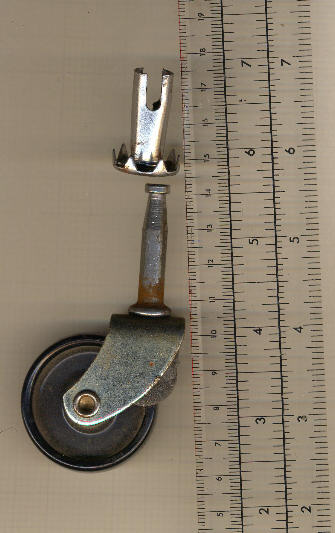A do-it-yourself guide from Edinburgh Woodturning - suppliers of high quality legs and bun feet for Sofas, chairs, beds, footstools and most furniture. www.edinburghwoodturning.com
Select a Fixing by reading this section.
If your furniture already has screw-in legs and you are sure they are 8 mm diameter then you do not need to read any further, just buy and fit.
If you have already bought legs with 8 mm dowel screws fitted only to find they do not fit your furniture, then this section will also help you.
Each section has photos of the furniture arrangement you are likely to be faced with. If you can match this to your specific problem, we can show you the solution.
1) The 8 mm dowel does not fit the existing fixings.
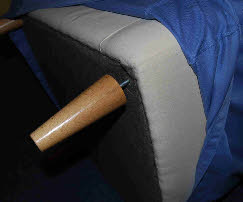 Your previous legs may have looked like they were 8 mm but if they do not fit
your furniture then the easiest solution is to fit the T-Nuts we automatically supply
with each purchase.
Your previous legs may have looked like they were 8 mm but if they do not fit
your furniture then the easiest solution is to fit the T-Nuts we automatically supply
with each purchase.
So now go to T-Nuts and follow the instructions.
2) There are no legs or feet fitted to my furniture.
The solution depends on a few factors. Some very modern sofas and chairs without legs actually have dense cardboard frames and as such are just unsuitable for legs.
You need to inspect the base of the furniture to find out what sort of construction it has. Get access to the underside of the furniture and remove some of the fabric covering (Hessian) near a corner so you can check the construction. You need a wooden frame suitable for fixing legs.
If you find flat wooden rails 18-42 mm thick then these should be fine for fixing T-Nuts. You do need access to the TOP of the rail to fit the T-Nut, if so go to T-Nuts and follow the instructions.
If you cannot get access to the TOP of the Wooden Rail then read on and you should find a solution you can use ( in section 4.)
3) I want to replace Castors or other Push-Fit feet.
Castors are normally a push -fit into an insert. Some manufacturers use a similar fitting for Bun Feet. Push-fittings cannot be used for higher legs i.e. where the leg is higher than it is wide.
The bun foot or castor normally has a metal spigot on it which clips into a metal insert. The insert is set into the wooden frame.
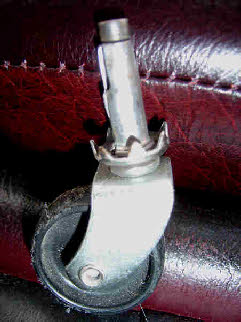 Often, when you pull out the castor, the insert comes with it as happened in the
photo on the left. The insert may be levered out with a screwdriver if it stays in
the frame.
Often, when you pull out the castor, the insert comes with it as happened in the
photo on the left. The insert may be levered out with a screwdriver if it stays in
the frame.
There are different types of insert and different spigots in use but they all follow the same general rules. The inserts will all lever out of the frame fairly easily and they are all unsuitable for long legs.
In the photo below, you can see the insert after it has been removed from the castor spigot.
After many years it is not uncommon for the insert to have rusted quite badly. If the insert breaks-up then the castor will collapse which often happens with old furniture.
We do not supply any products with push-in fittings and they should not be used for legs higher that 35 mm because the lever forces produced will cause the insert to pull out very quickly. True Bun Feet will not exert any force on this fitting so they are absolutely fine.
Inspect the frame around the insert and if there is good access to the Rail top then as long as the wooden rail is not thicker than 42 mm you should be able to fit T-Nuts quite easily. ( The insert will probably leave a hole about 10 mm diameter and this will need to be re-drilled to 12 mm diameter.)
Now Go to T-Nuts and check that section.
You may need to read on, look at the photos, and find a more appropriate solution.
4) There is no suitable wooden rail for the T-Nut
This is often found when you try to fit legs to a Divan Bed which has had castors fitted as in the picture below:
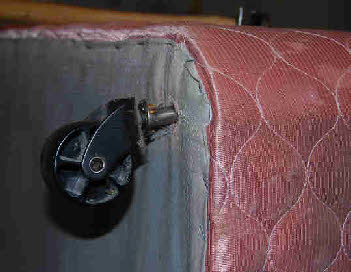 With many beds, after time the castor becomes loose and simply falls out when you
lift it up, as in the photo here.
With many beds, after time the castor becomes loose and simply falls out when you
lift it up, as in the photo here.
First remove the fabric around the area to see what the frame is like.
Some beds have flat metal plates on each corner. These may have 8 mm or 10 mm nuts welded onto them. The legs are screwed onto these plates. Use the original metal plates where possible after you have confirmed screw type.
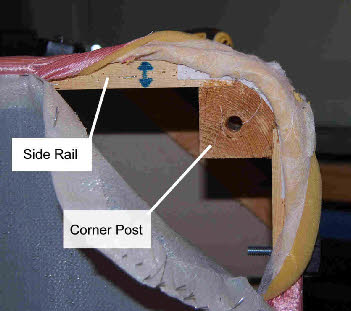 You can see the typical Divan bed construction. The side rails are vertical and the
corner post is an integral part of the Bed Frame.
You can see the typical Divan bed construction. The side rails are vertical and the
corner post is an integral part of the Bed Frame.
There is nowhere to fit a T-Nut.
The corner post is often 200-300 mm long.
The solution here is to fit an E-Nut which is easily done by following our instructions. Just click on the link above.
5) I want to increase the height of my furniture and use longer legs instead of Risers
This is quite common. Sofas, chairs and beds are often found to be too low, especially as we get older. Budget risers are simply blocks of plastic or wood which stack one on top of the other and they can be a cheap solution.
By using a solid fixing with longer legs you overcome many of the problems associated with risers which fall over when you try to move the furniture.
If you have 8 mm T-Nuts (or retained fixings) already fitted then just choose the height of leg you require.
If you need to fit E-Nuts, for instance to a Bed, then this fixing is perfectly strong for all the legs we supply. The fixing must be installed according to our guide.
6) Can I fit legs/feet to extend existing table legs
This is a common situation where the lower part of table legs have been damaged.
You can fit E-Nuts in the foot of the table leg to get a solid fitting as in the photo below. This should only be done where the existing legs are truly vertical.
It is not relevant whether the existing legs are turned or square.
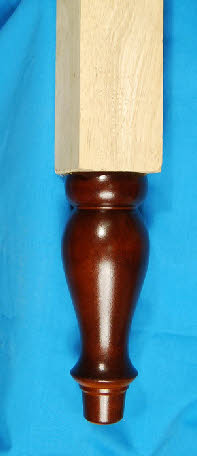 As long as the foot of the leg is a reasonable size, say 40 x 40 mm or about
35 mm diameter, then the E-Nut is a good solution.
As long as the foot of the leg is a reasonable size, say 40 x 40 mm or about
35 mm diameter, then the E-Nut is a good solution.
Go to E-Nuts and follow the instructions.
7) Conclusion
If you did not find your question answered here then please email us and send some photos if possible. We will reply with the best solution. We might also include your scenario within these pages (if you don’t mind.) because it will help others in the future.
